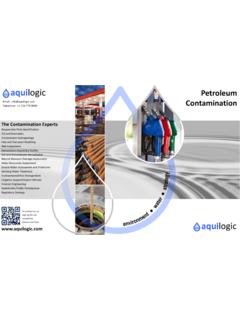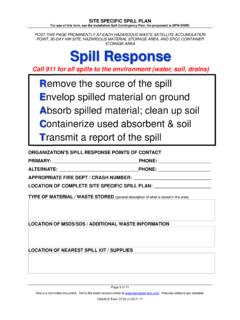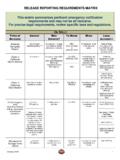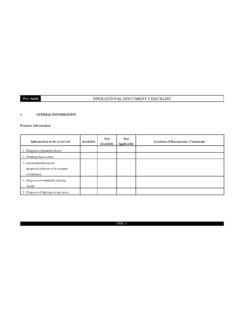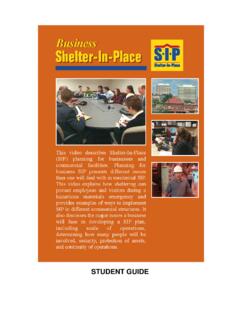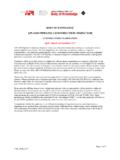Transcription of Private Party CERCLA Cost Recovery - aquilogic
1 1 245 Fischer Avenue, Suite D-2 Costa Mesa, CA 92626 Tel. + Web: November 2013 Private Party CERCLA cost Recovery Private parties, such as land owners, Cities or water utilities, are often faced with having to address contamination they did not release. Such a Party can implement the clean-up and seek cost Recovery . Alternatively, they can seek relief from the court requiring that the responsible parties (RPs) implement clean-up (injunctive relief) or seek damages from the RPs for the Private Party to subsequently implement the clean-up themselves (declaratory relief). Under either approach, Comprehensive Environmental Response, Compensation, and Liability Act ( CERCLA ) cost Recovery actions are often used because of the strict, retroactive, and joint and several liability provisions within the statute.
2 However, Private parties must be aware of what is required to ensure compliance with CERCLA and the National Oil and hazardous Substances Pollution Contingency Plan (NCP) when initiating such cost Recovery actions. This paper provides some rudimentary information to assist Private parties in implementing CERCLA clean-ups and/or cost Recovery actions. The paper provides a layman s perspective on Private cost Recovery action under CERCLA , and is not intended to offer legal advice or conclusions. Parties should seek legal counsel when considering whether to implement such cost Recovery actions. CERCLA The NCP defines the organizational structure and procedures for responding to discharges of oil and releases of hazardous substances, pollutants, and contaminants in the United States (US). The NCP was developed by the US Environmental Protection Agency (US EPA) in response to the enactment of CERCLA on December 11, 1980 (42 9601-9675), as amended by the Superfund Amendments and Reauthorization Act of 1986 (SARA), and by Section 311(d) of the Clean Water Act (CWA).
3 CERCLA created a tax on the chemical and petroleum industries (the Superfund) and provided broad Federal authority to respond directly to releases or threatened releases of hazardous substances that may endanger public health or the environment. CERCLA : (1) established requirements concerning closed and abandoned hazardous waste sites; (2) provided for liability of persons responsible for releases of hazardous waste at these sites; and (3) established a trust fund to provide for clean-up when no RP could be identified. The law authorizes the following two kinds of response actions: 2 Short-term removals, where prompt actions are needed to address releases or threatened releases; and Long-term remedial actions, that permanently and significantly reduce the dangers from releases of hazardous substances that are serious, but not immediately life threatening.
4 The NCP established more stringent requirements for remedial versus removal actions. The California hazardous Substances Account Act (HSAA) The Carpenter-Presley-Tanner hazardous substance Account Act (HSAA) (Health & Safety (H&S) Code, )[3] is often referred to as California s Superfund statute and the State s counterpart to CERCLA . As such, only costs incurred for response actions taken under, and consistent with, CERCLA or HSAA qualify for reimbursement under HSAA. In short, the HSAA provides a comprehensive and detailed program to ensure the timely and cost -effective clean up of hazardous substance release sites. It established authority, procedures, and standards to: Carry out the investigation, removal and remediation of contaminated sites; Issue and enforce a removal or remedial action order to any RP; Impose administrative or civil penalties for noncompliance of an order; Recover costs and expenses incurred by the California Department of Toxic Substances Control (DTSC) in carrying out the HSAA; Determine by binding arbitration the apportionment of liability of a RP; Seek contribution from other RPs; and Apply for compensation of loss caused by the release of a hazardous substance .
5 The CERCLA (or Superfund) Process There are several steps involved in cleaning up a release site under CERCLA . The Superfund clean-up process begins with site discovery or notification to US EPA of possible releases of hazardous substances. Sites are discovered by various parties, including citizens, State agencies, and US EPA Regional offices. US EPA, a designated State agency, or Private Party then implements the process below. Stakeholder involvement, regulatory enforcement actions, and emergency response can occur at various times during the process. Preliminary Assessment/ Site Inspection (PA/SI) National Priority List (NPL) Listing Remedial Investigation/Feasibility Study (RI/FS) Record of Decision (ROD) Remedial Design/ Remedial Action (RD/RA) Construction Completion Post-Construction Completion NPL Deletion Re-use 3 1.
6 PA/SI: Investigations of site conditions. If the release of hazardous substances requires immediate or short-term response actions, these are addressed under the Emergency Response Program of Superfund. 2. NPL Listing: A list of the most serious sites identified for long-term clean-up. A site need not be listed on the NPL for a CERCLA clean-up (and cost Recovery ) process to be implemented. 3. RI/FS: Determines the nature and extent of contamination. Assesses the treatability of site contamination, and evaluates the potential performance and cost of treatment technologies. Can include scoping, site characterization, development and screening of alternatives, treatability investigations, and detailed analysis of alternatives. 4. ROD: Explains which clean-up alternatives will be used at NPL sites. When federally-funded remedies exceed $25 million, they are reviewed by the National Remedy Review Board.
7 5. RD/RA: Preparation and implementation of plans and specifications for applying site remedies. The bulk of the clean-up usually occurs during this phase. All new fund-financed remedies are reviewed by the National Priorities Panel. 6. Construction completion: Identifies completion of physical clean-up construction, although this does not necessarily indicate whether final clean-up levels have been achieved. 7. Post-construction completion: Ensures that Superfund response actions provide for the long-term protection of human health and the environment. Included here are Long-Term Response Actions (LTRA), Operation and Maintenance (O&M), Institutional Controls, Five-Year Reviews, Remedy optimization. 8. NPL Deletion: Removes a site from the NPL once all response actions are complete and all clean-up goals have been achieved.
8 9. Re-use: Information on how the Superfund program is working with communities and other partners to return hazardous waste sites to safe and productive use without adversely affecting the remedy. One additional step that is often implemented as part of a CERCLA clean-up is interim remedial action . At many CERCLA clean-ups, especially those with multiple source sites, numerous responsible parties, and/or extensive groundwater contamination, the RI/FS process can take many years (in fact decades) to complete. Interim remedial action plans (iRAPs) are implemented during the overall RI/FS process to more expeditiously address known areas of contamination. In general, they are implemented to address ongoing sources of groundwater contamination ( source removal), control the continued migration of contamination ( plume control), and/or initiate resource restoration.
9 As part of the iRAP process, interim RI/FS documents may be prepared to support the selection of an interim remedy. In many cases, the interim remedy (or an expansion to the interim remedy) is eventually selected as the final remedy in the ROD. A flowchart that details one approach to the RI/FS process that incorporates interim remedies is provided as Figure 1. 4 Figure 1: RI/FS/iRAP Process 5 Stakeholder Participation Stakeholder participation (often referred to as community involvement) is the process of engaging in dialogue and collaboration with project stakeholders and community members. The goal of stakeholder participation is to advocate and strengthen meaningful participation during CERCLA clean-ups. As such, stakeholder participation strives to encourage and enable project stakeholder and community members to get involved, and keeps the community informed of ongoing and planned activities.
10 Consistency with NCP Under CERCLA , cost Recovery can only occur if the remedial actions were consistent with the NCP. The NCP specifies the steps a Party must undertake in selecting a remedy and cleaning up hazardous waste. A remedy is consistent with the NCP if the action, when evaluated as a whole, is in substantial compliance with, and results in, a CERCLA -quality clean-up. Among other requirements, the NCP requires that the Party seeking cost Recovery provide an opportunity for public comment and participation, evaluate the health and environmental threat, conduct a remedial investigation, prepare a feasibility study (that considers different treatment technologies, identifies all applicable or relevant and appropriate requirements [ARARs], and includes a cost analysis), and document all actions taken and that form the basis for the cost Recovery .

